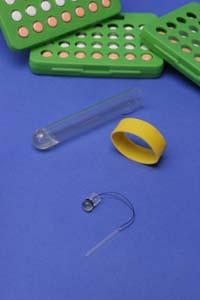When are new male contraceptives available?
2014/04/04 Galarraga Aiestaran, Ana - Elhuyar Zientzia
Although in recent years it has been announced several times, the male contraceptive pill has not yet been released. Neither pill nor others. Thus, in 2014 there are only two male contraceptives, condoms and vasectomy, and both have limits.
Condoms have great advantages: they are economical, easy to use and greatly protect from sexually transmitted diseases. Cons? It cannot be used when desired (the penis should be placed when tempted), it is not 100% effective (most errors are due to breaks or misuse) and some are allergic to latex (although there are condoms of other materials). On the other hand, there are those who refuse to use the condom for cultural or psychological reasons, and the evidence that the object itself does not help to overcome these drawbacks.
Vasectomy, on the other hand, is very effective and does not stand out at all. However, to cut the deferent tubes that bind the testicles to the seminal vesicle it is necessary to perform a small operation, after which another contraceptive should be used until there is no sperm in the semen and, above all, it is very difficult to go back.
For all this, researchers have been trying for years to create new male contraceptives. It has been treated with hormonal and non-hormonal methods, but none has reached the market.
With the hormones it has been tried to imitate the functioning of the female pill. The hormones that influence the development and functioning of gonads are the same in both men and women. Therefore, in testosterone it has been tried to avoid the production of testosterone, necessary for the maturation of sperm. However, in clinical trials, a decrease in libido and male characteristics was observed. To avoid these side effects, along with testosterone, have tried some synthetic hormones of female use, progestins. With this it seems that there are no side effects, but they do not get these hormones delivered in the pills, only by injection, patch or implant.
In the non-hormonal have tried two ways. On the one hand, they have performed a reversible vasectomy blocking the deferent tube with a synthetic polymer. It seems that this polymer is easy to place and remove and produces no side effects. On the other hand, synthetic drugs have tried to slow the development of sperm, for example by inhibiting an essential enzyme in development. And recently, by blocking two proteins, they have managed to avoid ejaculation without triggering orgasm. However, all of them have been tested for the moment only in the mouse.
And it seems that it will not be easy to arrive and overcome clinical tests. That's what Jalees Rehman, a researcher at the University of Illinois, thinks at least. She says that volunteers participating in clinical trials accept fewer side effects than women (since the birth control pill has side effects and is not insignificant and is nevertheless allowed). In parallel. The pharmaceutical industry has no special interest in supporting the investigation of male contraceptive methods, since the demand is not very evident. Finally, public institutions do not feel obliged to invest in it either. Therefore, if Rehman is not wrong and does not change the situation, it seems that the solution of the current imbalance will be extended.
Published in the newspaper Berria.

Gai honi buruzko eduki gehiago
Elhuyarrek garatutako teknologia





